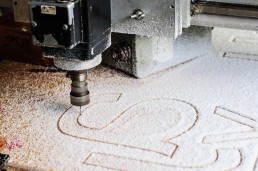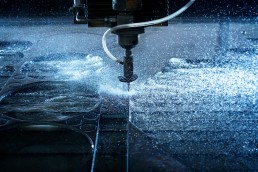CNC vs. Waterjet Cutting: Understanding the Best Choice for Your Project
When it comes to shaping materials into your desired form, two popular methods stand out: CNC (Computer Numerical Control) cutting and waterjet cutting. Each has unique advantages and applications, and choosing the right one can significantly impact the quality, efficiency, and cost of your project. This blog aims to demystify these two technologies, breaking down their differences in a way that’s easy to understand, whether you’re a complete beginner or someone with industry knowledge.

What is CNC Cutting?
CNC cutting is like a master sculptor, but instead of a chisel and hammer, it uses computer-controlled machines. Imagine a robotic arm that can drill, mill, or lathe. It follows a digital template you provide, precisely shaping materials like wood (plywood, MDF), plastics (acrylic, polycarbonate), and metals (aluminium). CNC is known for its precision, especially for complex designs and repeatable patterns. However, it does have limitations with thicker and harder materials.
What is Waterjet Cutting?
Now, picture a sculptor with a high-pressure water hose. Waterjet cutting uses a jet of water, sometimes mixed with abrasive materials, to slice through almost anything, from metals and stones to plastics and composites. It’s like the gentle giant of cutting technologies – powerful yet delicate enough to not damage the material with heat or mechanical stress. Waterjet is versatile, handling thicker and harder materials with ease, but it might not match the intricate detailing possible with CNC.

Key Differences
- Material Compatibility: CNC is great for softer materials and metals, but waterjet can handle a broader range, including thicker and harder materials.
- Precision and Detail: CNC excels in detailed and intricate designs. Waterjet is precise, but its cutting width can limit the fineness of detail.
- Heat Generation: CNC can produce heat, which might affect materials like plastics. Waterjet cutting is ‘cool’, avoiding heat-related issues.
- Cost and Speed: CNC might be quicker and more cost-effective for intricate designs in softer materials. Waterjet cutting is preferable for thicker materials but can be more expensive.
Choosing the Right Method for Your Project
Your choice between CNC and waterjet cutting will depend on:
- Material Type and Thickness: Softer, thinner materials? CNC might be your go-to. Thick, hard materials? Waterjet is the answer.
- Design Complexity: Need fine details and patterns? CNC’s precision is unbeatable. For less intricate shapes in tough materials, waterjet stands out.
- Budget and Time: Consider the cost and time for each method. Sometimes, a combination of both might offer the best solution.
Conclusion
Both CNC and waterjet cutting have their own superpowers. The choice largely depends on your project’s specific needs. Understanding these differences ensures you make an informed decision, resulting in the best outcome for your project.
Remember, no question is too small when it comes to your project’s success. Feel free to reach out to our experts for guidance tailored to your unique requirements.
Ready to start cutting?
Send us a message below and a member of our team will be in touch shortly to discuss your project.
